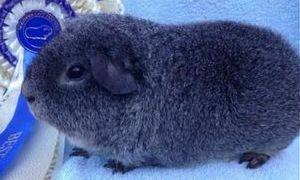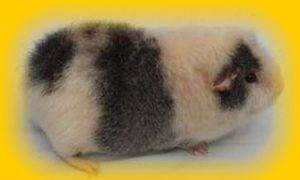As approved by the British Cavy Council June 2009
| Rex Standard | ||
| Points | ||
| Head, Eye & Ears | Head to be short and broad with a gently curving profile.Muzzle to be of good width and rounded at the nostrils.Eyes to be large, bright and bold and set with good width between.Ears to be large and drooping with lower rim parallel to the ground and set with good width bewteen. | 20 |
| Body Shape | To have short, cobby body; thick-set, with good width across shoulders.To be fit and of good substance with plenty of flesh covering shoulders.To have good size appropriate to age. | 15 |
| Coat Appearance | To have a crimped, erect coat appearing dense and even all over the body, with no areas of flatness or with coat tending to lie down.Guard hairs to be removed. Belly to be well covered.Coat length to be no more than 1.2cms (0.5in) in length, preferably shorter. | 20 |
| Coat Feel | Comprising of:Density: to have thick dense coat all over the body. (15)Springiness: to be springy and resilient when brushed with the palm of the hand, readily returning to the original erect appearance. (15)Texture: to be coarse to the touch, particularly on the top of the back, with allowance for a slightly less coarse feel to the sides. (15) To be clean and free from grease. | 45 |
Description of Colours
The following descriptions define the main colour groups and give guidance on the correct classes to enter when exhibiting at shows.
Rex Solid Colour

The cavy must be totally of one colour.
Any coloured different coloured hairs, visible on the surface of the coat, mean it should be shown as Any Other Colour (AOC).
A solid Rex which darkens at its points with age should continue to be shown as a Solid Colour throughout its show career.
Rex Agouti

The cavy must be totally Agouti, although normal Agouti belly colour is allowed.
Cavies showing faults that occur in smooth Agoutis, such as eye circles, lightness on chest, solid feet or belly colour extending onto legs or body are still Agouti.
Any patches of colour, no matter how small, mean that a cavy can not be shown in this class.Rex Agouti Bi-Colour

A bi-coloured (two coloured) cavy where one of the colours is Agouti.Golden Agouti and Gold or Silver Agouti and White are common examples of Rex Agouti Bi-Colour Rex AOC (Any Other Colour)

Any other Rex cavy that does not conform to the above categories, eg Argente Rex, Himalayan Rex or Dalmatian.Guidance Notes
The Rex is a short-coated cavy with a rexoid coat, which should appear crimped and erect from the body. The feel of the coat is particularly important, being dense and even all over the body, but springy and resilient to the touch.
When the coat is brushed forward there should be no tendency for it to lie in that direction. Instead it should return it its original erect appearance.
Colour and Coat marking are used only to divide Rex classes at shows. No points are awarded for Colour or Coat markings.
Whilst the preference is for a curly or wavy belly, a straight one should not be unduly penalised.
Allowance should be made for the fact that younger exhibits will, generally, have a softer coat.Specific Disqualifications
Rosettes or partial rosettes in the coat.Specific Faults
Extreme tendency for parting in the centre of the back.
Coat length over 1.2cm (0.5in)
Soft coat on top of body
Flatness anywhere on bdy
Presence of guard hairs